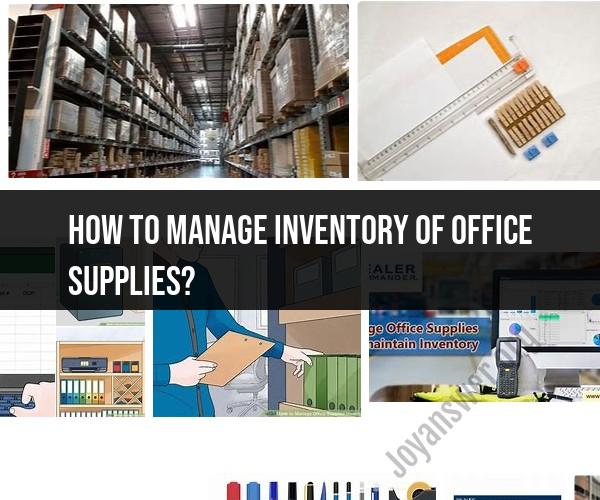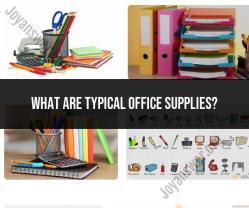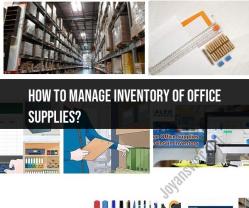How to manage inventory of office supplies?
Effective inventory management of office supplies is essential to ensure that your workplace runs smoothly without interruptions. Here are some practices to help you manage office supplies efficiently:
Centralized Storage:
- Designate a central storage area for office supplies. This makes it easier to keep track of items and prevents hoarding in individual offices or departments.
Categorization and Labeling:
- Categorize office supplies into groups (e.g., writing instruments, paper products, stationery) and use clear labels on shelves or storage bins to indicate the contents.
Inventory List:
- Create and maintain a comprehensive inventory list of all office supplies. Include item names, quantities, reorder points, and locations.
Reorder Points:
- Establish reorder points for frequently used items. When the stock falls below these points, it's time to reorder to avoid running out.
Regular Audits:
- Conduct regular audits of your office supplies. This involves physically checking the inventory against your inventory list to identify discrepancies or items that need replenishing.
First-In, First-Out (FIFO):
- Use the FIFO method for managing items with expiration dates or items that degrade over time (e.g., batteries, printer ink). This ensures that older items are used first.
Supplier Relationships:
- Establish good relationships with your office supply vendors. Consider negotiating favorable terms, discounts, or bulk purchasing options.
Budgeting:
- Create an annual office supplies budget. This helps you allocate funds appropriately and prevents overspending.
Online Inventory Management Software:
- Consider using inventory management software or apps to track and manage your office supplies electronically. These tools can automate reorder processes and provide real-time insights.
Employee Responsibility:
- Assign responsibility for office supply management to a specific individual or department. This person or team can oversee ordering, tracking, and distribution.
Employee Training:
- Educate employees on the importance of responsible office supply use and management. Encourage them to report when supplies are running low or when there's excess stock.
Standardized Supplies:
- Standardize the type and brand of frequently used office supplies (e.g., pens, notepads) to simplify ordering and reduce confusion.
Bulk Purchasing:
- Whenever possible, purchase office supplies in bulk to take advantage of cost savings. Be mindful of storage space limitations.
Monitor Usage Patterns:
- Track the consumption of office supplies over time to identify patterns and adjust your ordering accordingly.
Dispose of Unusable Items:
- Regularly assess the condition of office supplies. Dispose of items that are damaged, outdated, or no longer usable.
Emergency Supplies:
- Maintain a small inventory of emergency supplies for unexpected situations, such as power outages or supply chain disruptions.
Communication:
- Foster open communication among employees regarding office supplies. Encourage them to request items as needed rather than hoarding supplies.
Review and Adjust:
- Periodically review your inventory management practices and make adjustments based on changes in demand, office size, or budget constraints.
Efficient inventory management not only saves time and money but also ensures that your office operates smoothly. Regularly assess your inventory processes and adapt them as necessary to meet the evolving needs of your organization.
Inventory Management for Office Supplies: Best Practices
Inventory management is the process of tracking and controlling the flow of goods into and out of a business. It is an essential part of any business, but it is especially important for businesses that sell or use a lot of office supplies.
Here are some best practices for inventory management for office supplies:
- Establish a system for tracking inventory. This could be a simple spreadsheet or a more sophisticated inventory management software program.
- Conduct regular inventory audits. This will help to ensure that your records are accurate and that you identify any discrepancies early on.
- Set reorder points. This is the level at which you need to reorder an item to avoid running out.
- Use a first-in, first-out (FIFO) system. This means using the oldest items in inventory first. This helps to prevent items from expiring or becoming obsolete.
- Organize your inventory. This will make it easier to find items when you need them.
- Secure your inventory. This will help to prevent theft and loss.
Tracking and Replenishing: How to Efficiently Manage Office Supply Inventory
One of the most important aspects of inventory management is tracking and replenishing stock. This can be done manually, but it is much more efficient to use a software program.
A good inventory management software program will allow you to:
- Track inventory levels in real time
- Set reorder points
- Generate reports on inventory usage and trends
- Automate the replenishment process
From Stockroom to Desk: A Systematic Approach to Office Supply Control
To efficiently manage office supply inventory, it is important to have a systematic approach. This approach should include the following steps:
- Receiving: When office supplies are received, they should be checked in and added to the inventory system.
- Storage: Office supplies should be stored in a secure and organized location.
- Issuance: Office supplies should be issued to employees on an as-needed basis. This can be done manually or through a self-service system.
- Replenishment: When office supply inventory levels reach a reorder point, new supplies should be ordered.
By following these steps, you can create a systematic approach to office supply control that will help to ensure that you always have the supplies you need, when you need them.
Here are some additional tips for efficiently managing office supply inventory:
- Use a central storage location. This will make it easier to track and manage inventory levels.
- Organize inventory by category. This will make it easier to find items when you need them.
- Label all items clearly. This will help to prevent mistakes when issuing or replenishing inventory.
- Use a self-service system for issuing office supplies. This can save time and reduce the workload on your staff.
- Train your employees on how to use the inventory system. This will help to ensure that everyone is on the same page and that the system is used correctly.
By following these tips, you can efficiently manage your office supply inventory and ensure that your business always has the supplies it needs.







